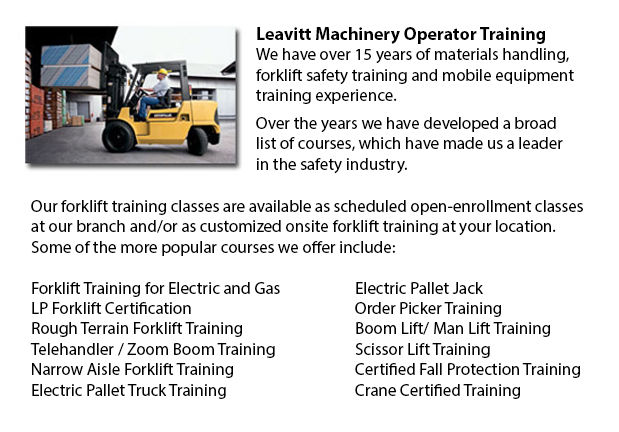
Rough Terrain Forklifts Training Guelph - There are in actual fact two distinctive classifications of lift trucks within the materials handling industry, the industrial model and the rough terrain model. Rough terrain lift trucks first came on the market in the 1940's and had been predominantly utilized on irregular roads, ideal for places where no paved roads were existing, like construction sites and lumberyards.
Typically, nearly all rough terrain forklifts are run on a propane, diesel or gasoline powered internal combustion engines with a battery used for power. A number of makers are experimenting with rough ground lift trucks that consume vegetable matter and run from ethanol. Large pneumatic tires with deep treads typify these forklifts to allow them to grasp onto the roughest soil type devoid of any slippage or sliding.
The most primitive versions of rough terrain forklifts were able to carry weights of up to 1000 lbs, with forks that could slide beneath the item, raise it a slight bit and then transport it to another location. After some time on the market, rough terrain vehicles had been given additional shipping power to about 2000 lbs capacity. In the 1960's telescoping booms were added, enabling them to stack materials a great deal higher than in earlier years. The telescoping design characteristic is a staple of nearly all all terrain forklifts nowadays. Present models are capable of managing well over 4000 lbs due to the constant enhancements over the years. Telescoping ability has also improved with some versions attaining a height of 35 feet. Operator safety has also become a focus with many all terrain lift trucks now designed are outfitted with an enclosed cab for the operator, as opposed to the older open air seating capacity.
The rough terrain lift trucks on the market these days both function skillfully on unpaved roads and paved floors. This style of rough terrain forklift is marketed for its' adaptability enabling the opportunity for establishments to utilize one unit to transport resources from an outside working area into a warehouse.
-
Boom Trucks
Boom Trucks Training Guelph - Boom truck are often applied by phone, cable and utilities companies as they have long folded arms which are typically folded over the roofs of company vans. On the end of the extension of extendable arms more often than... More -
Clark Forklift
Clark Forklift Forklift Training - Performing globally, there are currently 350,000 Clark forklifts and lift vehicles in operation, with upwards of 250,000 of those in commission in North America. Clark has five main lines of lift trucks across the w... More -
Nissan Forklift
Nissan Forklift Training Guelph - Nissan prides itself on achieving complete client satisfaction when their buyer is enjoying one of their many trucks, cars or lift trucks. Nissan Forklift division is a wholly owned subsidiary of Nissan Motor Co. Ltd... More -
Pallet Lifts
Pallet Lifts Training Guelph - A pallet haul is equipment built in particular for moving pallets of irregular weights and dimensions. They may be utilized in conjunction with cranes, lift trucks and other heavy duty machinery as an appendage piece or... More -
Doosan Forklift
Doosan Forklift Training Guelph - Doosan Infracore Company Ltd. is an international and intercontinental organization that features Defense Industry Products, Industrial Vehicles, Diesel Engines, Automation Systems, Machine Tools and Construction Eq... More

Forklift Certification Guelph
TOLL FREE: 1-888-254-6157
Guelph, Ontario
forkliftcertificationguelph.com
Email Us
About Us


